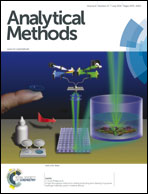Determination of trace fungicides in environmental water samples using poly(HPMA-EDMA) monolith microextraction coupled to high performance liquid chromatography†
Abstract
A simple, rapid and sensitive strategy has been presented for the simultaneous determination of three fungicides (azoxystrobin, diethofencarb and pyrimethanil) in water samples by coupling polymer monolith microextraction (PMME) to high performance liquid chromatography. A novel poly(2-hydroxypropyl methacrylate-ethylene dimethacrylate) (HPMA-EDMA) monolithic capillary column was synthesized and selected as the extraction medium for the PMME. To achieve optimum extraction performance, the conditions of the PMME including sample flow rate, sample pH, eluent volume, eluent flow rate, sample volume and salt effect have been investigated. Under the optimum conditions, the limits of detection of azoxystrobin, diethofencarb and pyrimethanil are 0.19, 0.22 and 0.65 μg L−1, respectively. The reproducibility of the method was obtained with intra-day and inter-day relative standard deviations less than 3.1% and 6.3%, respectively. The proposed method has been successfully applied to the determination of the three fungicides in environmental water samples with a recovery range of 80.2–115.6% for all the samples.


 Please wait while we load your content...
Please wait while we load your content...